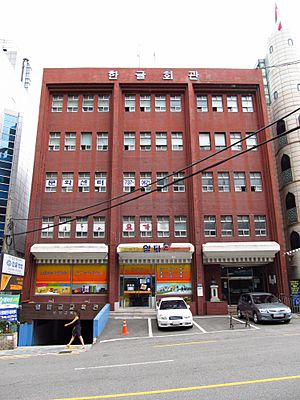Korean language facts for kids
Quick facts for kids Korean |
|
|---|---|
| Hangugeo, Chosŏnmal | |

Two names for Korean, Hangugeo and Chosŏnmal, written vertically in hangul
|
|
| Native to | South Korea North Korea Jilin·Liaoning·Heilongjiang, China Japan (Koreans in Japan) |
| Native speakers | 76 million (2007) |
| Language family |
isolated
|
| Early forms: |
Old Korean
|
| Dialects | |
| Writing system | Hangul (primary) Hanja (mixed script) Korean Braille Cyrillic (Koryo-mar) |
| Official status | |
| Official language in | |
The Korean language (Korean), is spoken mainly in North and South Korea. It is spoken by more than 78 million people (most of whom are North or South Koreans).
In South Korea, it is called han'gukmal or han'gugeo. In North Korea, however, it is called chosŏnmal or chosŏnŏ. They are named differently because the common names for North and South Korea are different. In additional, Koreans usually call their language, "our language" or "our country's language".
Writing

The Korean language uses two different writing systems. The first is Hangul, the main alphabet. In North Korea, only Hangeul (Known as Chosǒngǔl in North Korea) is used by law. In South Korea, only Hangeul should be used in most public areas like education, but the second system, Hanja, is still used in some newspapers and professional areas.
Hanja is the system of Chinese characters that are used in Korean. Hanja was the only way to write Korean before the creation of Hangeul in the 15th century, and it was common in novels before the 19th century.
Despite the fact that King Sejong the Great led the development of Hangeul in order to allow literacy to spread among common people and to create a writing system that more accurately represented the Korean language than Hanja, it was not adopted by the upper classes of Koreans, and therefore Hanja would continue to be the official writing system util the late 19th century.
Despite it being rejected by the elite classes, Hangeul was used often by lower classes as a way to write down Korean literature and for lower classes to communicate with each other.
Images for kids
-
The Latin alphabet used in romanization on road signs, for foreigners in South Korea
-
Highway sign in Korean and English, Daegu, South Korea
See also
 In Spanish: Idioma coreano para niños
In Spanish: Idioma coreano para niños






